Economic and Environmental Changes in Shenzhen—A Technology Hub in Southern China
Abstract
1. Introduction
2. Literature Review
2.1. Economic Growth and Environmental Change
2.2. Shenzhen as a Member of the World’s Cities and Its Haze Conditions
3. Materials and Methods
3.1. Data and Data Sources
3.2. Environmental Kuznets Curve
3.3. Determination of Energy Use and the Associated GHG Emission in the Computer, Communication and Electronic Product Manufacturing Industry
4. Results
4.1. Shenzhen’s Economic Development
4.2. Environmental Kuznets Curve
4.3. Gross Output Value of Industry and Outputs of the Computer, Communcaition and Electronic Product Manufacturers
Energy Consumption and GHG Emission in the Computer, Communication and Electronic Product Industry
5. Discussion
6. Conclusions
Author Contributions
Funding
Institutional Review Board Statement
Informed Consent Statement
Data Availability Statement
Conflicts of Interest
References
- Bao, S.; Chang, G.H.; Sachs, J.D.; Woo, W.T. Geographic factors and China’s regional development under market reforms, 1978–1998. China Econ. Rev. 2002, 13, 89–111. [Google Scholar] [CrossRef]
- Yeung, Y.M.; Lee, J.; Kee, G. China’s special economic zones at 30. Eurasian Geogr. Econ. 2009, 50, 222–240. [Google Scholar] [CrossRef]
- Statistics Bureau of Shenzhen Municipality. Shenzhen Statistical Yearbook—2019; China Statistics Press Co. Ltd.: Beijing, China, 2019. [Google Scholar]
- To, W.M.; Lee, P.K.C. Energy consumption and economic development in Hong Kong, China. Energies 2017, 10, 1883. [Google Scholar] [CrossRef]
- To, W.M.; Lee, P.K.C. A triple bottom line analysis of Hong Kong’s logistics sector. Sustainability 2017, 9, 388. [Google Scholar] [CrossRef]
- To, W.M.; Lee, P.K.C.; Lai, T.M. Modeling of monthly residential and commercial electricity consumption using nonlinear seasonal models—The case of Hong Kong. Energies 2017, 10, 885. [Google Scholar] [CrossRef]
- Ma, J.; Rui, G. Xi Jinping Calls on Shenzhen to Create ‘Another Miracle’ in Next Stage of Reform; South China Morning Post: Hong Kong, China, 2020; Available online: https://www.scmp.com/news/china/politics/article/3105519/xi-exhorts-shenzhen-step-and-lead-china-out-pandemic-innovation (accessed on 5 April 2021).
- Yang, Y.; Lau, A.K.W.; Lee, P.K.C.; Yeung, A.C.L.; Cheng, T.C.E. Efficacy of China’s strategic environmental management in its institutional environment. Int. J. Operat. Prod. Manag. 2019, 39, 138–163. [Google Scholar] [CrossRef]
- Lau, A.K.; Lee, P.K.C.; Cheng, T.C.E. An empirical taxonomy of corporate social responsibility in China’s manufacturing industries. J. Clean. Prod. 2018, 188, 322–338. [Google Scholar] [CrossRef]
- Jing, J.J.; Ye, B.; Ma, Y. The construction of Shenzhen’s carbon emission trading scheme. Energy Policy 2014, 75, 17–21. [Google Scholar] [CrossRef]
- Wang, M.J.; Zhu, X.Y.; Chen, S.P. Characteristics of haze weathers with different level in Shenzhen during 1981–2010. China Environ. Sci. 2013, 33, 1563–1568. [Google Scholar]
- Wang, M.J.; Zhang, L.; Zhang, L.L.; Xie, X.M.; Li, S.F. Seasonal characteristics and pollution of haze in Shenzhen based on meticulous observation data. China Environ. Sci. 2015, 35, 3562–3569. [Google Scholar]
- Zhao, Y.B.; Gao, P.P.; Yang, W.D.; Ni, H.G. Vehicle exhaust: An overstated cause of haze in China. Sci. Total Environ. 2018, 612, 490–491. [Google Scholar] [CrossRef]
- Yang, Y.; Liao, H.; Lou, S. Increase in winter haze over eastern China in recent decades: Roles of variations in meteorological parameters and anthropogenic emissions. J. Geophys. Res. Atmos. 2016, 121, 13050–13065. [Google Scholar] [CrossRef]
- To, W.M. Association between energy use and poor visibility in Hong Kong SAR, China. Energy 2014, 68, 12–20. [Google Scholar] [CrossRef] [PubMed]
- To, W.M.; Lee, P.K.C.; Ng, C.T. Factors contributing to haze pollution: Evidence from Macao, China. Energies 2017, 10, 1352. [Google Scholar] [CrossRef]
- Liu, T.; Zhang, Y.H.; Xu, Y.J.; Lin, H.L.; Xu, X.J.; Luo, Y.; Xiao, J.P.; Zeng, W.L.; Zhang, W.F.; Chu, C.; et al. The effects of dust–haze on mortality are modified by seasons and individual characteristics in Guangzhou, China. Environ. Poll. 2014, 187, 116–123. [Google Scholar] [CrossRef]
- Gu, S.; Yang, J.; Woodward, A.; Li, M.; He, T.; Wang, A.; Lu, B.; Liu, X.; Xu, G.; Liu, Q. The short-term effects of visibility and haze on Mortality in a coastal city of China: A time-series study. Int. J. Environ. Res. Public Health 2017, 14, 1419. [Google Scholar] [CrossRef] [PubMed]
- Zeng, W.; Liu, T.; Du, Q.; Li, J.; Xiao, J.; Guo, L.; Li, X.; Xu, Y.; Xu, X.; Wan, D.; et al. The interplay of haze characteristics on mortality in the Pearl River Delta of China. Environ. Res. 2020, 184, 109279. [Google Scholar] [CrossRef] [PubMed]
- Wang, X.; Ding, X.; Fu, X.; He, Q.; Wang, S.; Bernard, F.; Zhao, X.; Wu, D. Aerosol scattering coefficients and major chemical compositions of fine particles observed at a rural site in the central Pearl River Delta, South China. J. Environ. Sci. 2012, 24, 72–77. [Google Scholar] [CrossRef]
- Dai, W.; Gao, J.; Cao, G.; Ouyang, F. Chemical composition and source identification of PM2. 5 in the suburb of Shenzhen, China. Atmos. Res. 2013, 122, 391–400. [Google Scholar] [CrossRef]
- Li, Y.; Zhan, C.; de Jong, M.; Lukszo, Z. Business innovation and government regulation for the promotion of electric vehicle use: Lessons from Shenzhen, China. J. Clean. Prod. 2016, 134, 371–383. [Google Scholar] [CrossRef]
- Li, M.; Ye, H.; Liao, X.; Ji, J.; Ma, X. How Shenzhen, China pioneered the widespread adoption of electric vehicles in a major city: Implications for global implementation. WIRES Energy Environ. 2020, 9, e373. [Google Scholar] [CrossRef]
- Yang, L.; Cai, Y.; Zhong, X.; Shi, Y.; Zhang, Z. A carbon emission evaluation for an integrated logistics system—A case study of the port of Shenzhen. Sustainability 2017, 9, 462. [Google Scholar] [CrossRef]
- Liu, J.; Chen, Q.; Lang, X.; Wang, Y.; Fan, S. Analysis on the development prospect of natural gas utilization in Shenzhen. Int. J. Low-Carbon Technol. 2012, 7, 264–270. [Google Scholar] [CrossRef][Green Version]
- Wu, Z.; Tang, J.; Wang, D. Low carbon urban transitioning in Shenzhen: A multi-level environmental governance perspective. Sustainability 2016, 8, 720. [Google Scholar] [CrossRef]
- Chang, C.L.; Mai, T.K.; McAleer, M. Pricing carbon emissions in China. Ann. Financ. Econ. 2018, 13, 1850014. [Google Scholar] [CrossRef]
- Lü, H.; Huang, Y.H.; Huang, X.J.; Cai, Q.Y. The state of particulate matter contamination, particulate matter–bound heavy metals, and persistent organic pollutants (POPs) in megacities, China. Curr. Opin. Environ. Sci. Health 2019, 8, 15–22. [Google Scholar] [CrossRef]
- Zhang, L.; Li, L.; Chan, P.W.; Liang, B.; Zhang, L. Why the number of haze days in Shenzhen, China has reduced since 2005: From a perspective of industrial structure. Mausam 2018, 69, 45–54. [Google Scholar]
- The World Economic Forum. The Astonishing Rise of Shenzhen, China’s Gadget Capital; The World Economic Forum: Geneva, Switzerland, 2017; Available online: https://www.weforum.org/agenda/2017/11/inside-shenzhen-china-s-gadget-capital/ (accessed on 5 April 2021).
- Kraft, J.; Kraft, A. On the relationship between energy and GNP. J. Energy Dev. 1978, 3, 401–403. [Google Scholar]
- Eden, S.H.; Hwang, B.K. The relationship between energy and GNP: Further results. Energy Econ. 1984, 6, 186–190. [Google Scholar]
- Yu, E.S.; Choi, J.Y. The causal relationship between energy and GNP: An international comparison. J. Energy Dev. 1985, 13, 249–272. [Google Scholar]
- Asafu-Adjaye, J. The relationship between energy consumption, energy prices and economic growth: Time series evidence from Asian developing countries. Energy Econ. 2000, 22, 615–625. [Google Scholar] [CrossRef]
- Ozturk, I.; Acaravci, A. CO2 emissions, energy consumption and economic growth in Turkey. Renew. Sustain. Energy Rev. 2010, 14, 3220–3225. [Google Scholar] [CrossRef]
- Lai, T.M.; To, W.M.; Lo, W.C.; Choy, Y.S.; Lam, K.H. The causal relationship between electricity consumption and economic growth in a gaming and tourism center: The case of Macao SAR, the People’s Republic of China. Energy 2011, 36, 1134–1142. [Google Scholar] [CrossRef] [PubMed]
- Okyay, U.; Ebru, A.; Fatih, Y. Energy consumption and economic growth nexus: Evidence from developed countries in Europe. Int. J. Energy Econ. Policy 2014, 4, 411–419. [Google Scholar]
- Bölük, G.; Mert, M. Fossil and renewable energy consumption, GHGs (greenhouse gases) and economic growth: Evidence from a panel of EU (European Union) countries. Energy 2014, 74, 439–446. [Google Scholar] [CrossRef]
- Saidi, K.; Hammami, S. The impact of CO2 emissions and economic growth on energy consumption in 58 countries. Energy Rep. 2015, 1, 62–70. [Google Scholar] [CrossRef]
- Ben Mbarek, M.; Boukarraa, B.; Saidi, K. Role of energy consumption and economic growth in the spread of greenhouse emissions: Empirical evidence from Spain. Environ. Earth Sci. 2016, 75, 1161–1169. [Google Scholar] [CrossRef]
- Ozturk, F. Energy consumption—GDP causality in MENA countries. Energy Source Part. B Econ. Plan. Policy 2017, 12, 231–236. [Google Scholar] [CrossRef]
- Sek, S.K.; Chu, J.F. Investigating economic growth-energy consumption-environmental degradation nexus in China. Int. J. Adv. Appl. Sci. 2017, 4, 21–25. [Google Scholar] [CrossRef]
- Riti, J.S.; Song, D.Y.; Shu, Y.; Kamah, M. Decoupling CO2 emission and economic growth in China: Is there consistency in estimation results in analyzing environmental Kuznets curve? J. Clean. Prod. 2017, 166, 1448–1461. [Google Scholar] [CrossRef]
- Yang, X.C.; Lou, F.; Sun, M.X.; Wang, R.Q.; Wang, Y.T. Study of the relationship between greenhouse gas emissions and the economic growth of Russia based on the Environmental Kuznets Curve. Appl. Energy 2017, 193, 162–173. [Google Scholar] [CrossRef]
- Sterpu, M.; Soava, G.; Mehedintu, A. Impact of economic growth and energy consumption on greenhouse gas emissions: Testing environmental curves hypotheses on EU countries. Sustainability 2018, 10, 3327. [Google Scholar] [CrossRef]
- Bilan, Y.; Streimikiene, D.; Vasylieva, T.; Lyulyov, O.; Pimonenko, T.; Pavlyk, A. Linking between renewable energy, CO2 emissions, and economic growth: Challenges for candidates and potential candidates for the EU membership. Sustainability 2019, 11, 1528. [Google Scholar] [CrossRef]
- Lyeonov, S.; Pimonenko, T.; Bilan, Y.; Štreimikienė, D.; Mentel, G. Assessment of green investments’ impact on sustainable development: Linking gross domestic product per capita, greenhouse gas emissions and renewable energy. Energies 2019, 12, 3891. [Google Scholar] [CrossRef]
- Kasperowicz, R.; Bilan, Y.; Štreimikienė, D. The renewable energy and economic growth nexus in European countries. Sustain. Dev. 2020, 28, 1086–1093. [Google Scholar] [CrossRef]
- Wu, X.; Li, X. Effects of mass media exposure and social network site involvement on risk perception of and precautionary behavior toward the haze issue in China. Int. J. Commun. 2017, 11, 23. [Google Scholar]
- Zhao, M.; Zhang, M.; Ying, J.; Wang, S.; Shi, Y.; Li, H.; Li, Y.; Xing, Z.; Sun, J. Knowledge, attitudes, practices and information demand in relation to haze in China: A cross-sectional study. BMC Public Health 2019, 19, 1–11. [Google Scholar] [CrossRef]
- Jia, H.; Wang, L. Peering into China’s thick haze of air pollution. Chem. Eng. News 2017, 95, 19–22. Available online: https://cen.acs.org/articles/95/i4/Peering-Chinas-thick-haze-air (accessed on 5 April 2021).
- Derudder, B.; Cao, Z.; Liu, X.; Shen, W.; Dai, L.; Zhang, W.; Caset, F.; Witlox, F.; Taylor, P.J. Changing connectivities of Chinese cities in the world city network, 2010–2016. Chin. Geogr. Sci. 2018, 28, 183–201. [Google Scholar] [CrossRef]
- Dorocki, S.; Raźniak, P.; Winiarczyk-Raźniak, A.; Boguś, M. The role of global cities in creation of innovative industry sectors—Case study—Life sciences sector. In Proceedings of the 5th International Conference IMES, Prague, Czech Republic, 25–26 May 2017. [Google Scholar]
- Raźniak, P.; Dorocki, S.; Winiarczyk-Raźniak, A. Spatial changes in the command and control function of cities based on the corporate centre of gravity model. Miscellanea Geogr. Reg. Stud. Dev. 2020, 24, 35–41. [Google Scholar] [CrossRef]
- Statistics Bureau of Shenzhen Municipality. Shenzhen Statistical Yearbook (Various Issues from 1990 to 2020); China Statistics Press Co. Ltd.: Beijing, China, 2021. [Google Scholar]
- Shenzhen Municipal Government. Shenzhen Municipal Statistical Communiqué on Economic and Social Development (Various Issues from 2000 to 2020); Shenzhen Municipal Government: Shenzhen, China, 2021.
- Kuznets, S. Economic growth and income inequality. Am. Econ. Rev. 1955, 45, 1–28. [Google Scholar]
- Van Alstine, J.; Neumayer, E. The environmental Kuznets curve. In Handbook on Trade and the Environment; Gallagher, K., Ed.; Edward Elgar Publishing, Inc.: Northampton, MA, USA, 2010; pp. 49–59. [Google Scholar]
- The World Bank. World Development Report 1992; Oxford University Press: New York, NY, USA, 1992. [Google Scholar]
- Munasinghe, M. Is environmental degradation an inevitable consequence of economic growth: Tunneling through the environmental Kuznets curve. Ecol. Econ. 1999, 29, 89–109. [Google Scholar] [CrossRef]
- Neagu, O. The link between economic complexity and carbon emissions in the European Union countries: A model based on the Environmental Kuznets Curve (EKC) approach. Sustainability 2019, 11, 4753. [Google Scholar] [CrossRef]
- Xu, Q.; Dong, Y.X.; Yang, R. Urbanization impact on carbon emissions in the Pearl River Delta region: Kuznets curve relationships. J. Clean. Prod. 2018, 180, 514–523. [Google Scholar] [CrossRef]
- Intergovernmental Panel on Climate Change (IPCC). 2006 IPCC guidelines for national greenhouse gas inventories. In IPCC National Greenhouse Gas—Inventories Programme; Egglestrom, S., Buendia, L., Miwa, K., Ngara, T., Tanabe, K., Eds.; Intergovernmental Panel on Climate Change: Geneva, Switzerland, 2010. [Google Scholar]
- Intergovernmental Panel on Climate Change (IPCC). Climate Change 2014—Synthesis Report—IPCC Fifth Assessment Report (AR5); Intergovernmental Panel on Climate Change: Geneva, Switzerland, 2015. [Google Scholar]
- Xiong, S.; Ji, J.; Ma, X. Comparative life cycle energy and GHG emission analysis for BEVs and PHEVs: A case study in China. Energies 2019, 12, 834. [Google Scholar] [CrossRef]
- Smith, K.; Liu, S.; Chang, T. Contribution of urban water supply to greenhouse gas emissions in China. J. Ind. Ecol. 2016, 20, 792–802. [Google Scholar] [CrossRef]
- To, W.M.; Lai, T.M.; Lo, W.C.; Lam, K.H.; Chung, W.L. The growth pattern and fuel life cycle analysis of the electricity consumption of Hong Kong. Environ. Pollut. 2012, 165, 1–10. [Google Scholar] [CrossRef]
- Yuan, Y.; Guo, H.; Xu, H.; Li, W.; Luo, S.; Lin, H.; Yuan, Y. China’s first special economic zone: The case of Shenzhen. In Building Engines for Growth and Competitiveness in China: Experience with Special Economic Zones and Industrial Clusters; Zeng, D.Z., Ed.; World Bank Publications: Washington, DC, USA, 2010; pp. 55–86. [Google Scholar]
- Luo, Y.; Chan, R.C. Production of coworking spaces: Evidence from Shenzhen, China. Geoforum 2020, 110, 97–105. [Google Scholar] [CrossRef]
- Koster, H.R.; Cheng, F.F.; Gerritse, M.; van Oort, F.G. Place-based policies, firm productivity, and displacement effects: Evidence from Shenzhen, China. J. Regional Sci. 2019, 59, 187–213. [Google Scholar] [CrossRef]
- Du, J. The Shenzhen Experiment: The Story of China’s Instant City; Harvard University Press: Cambridge, MA, USA, 2020. [Google Scholar]
- Lin, X.; Liu, B.; Han, J.; Chen, X. Industrial upgrading based on global innovation chains: A case study of Huawei technologies Co., Ltd. Shenzhen. Int. J. Innov. Stud. 2018, 2, 81–90. [Google Scholar] [CrossRef]
- Ouyang, X.; Mao, X.; Sun, C.; Du, K. Industrial energy efficiency and driving forces behind efficiency improvement: Evidence from the Pearl River Delta urban agglomeration in China. J. Clean. Prod. 2019, 220, 899–909. [Google Scholar] [CrossRef]
- Lim, W.M.; To, W.M. The economic impact of a global pandemic on the tourism economy: The case of COVID-19 and Macao’s destination-and gambling-dependent economy. Curr. Issues Tour. 2021, 1–12. [Google Scholar] [CrossRef]
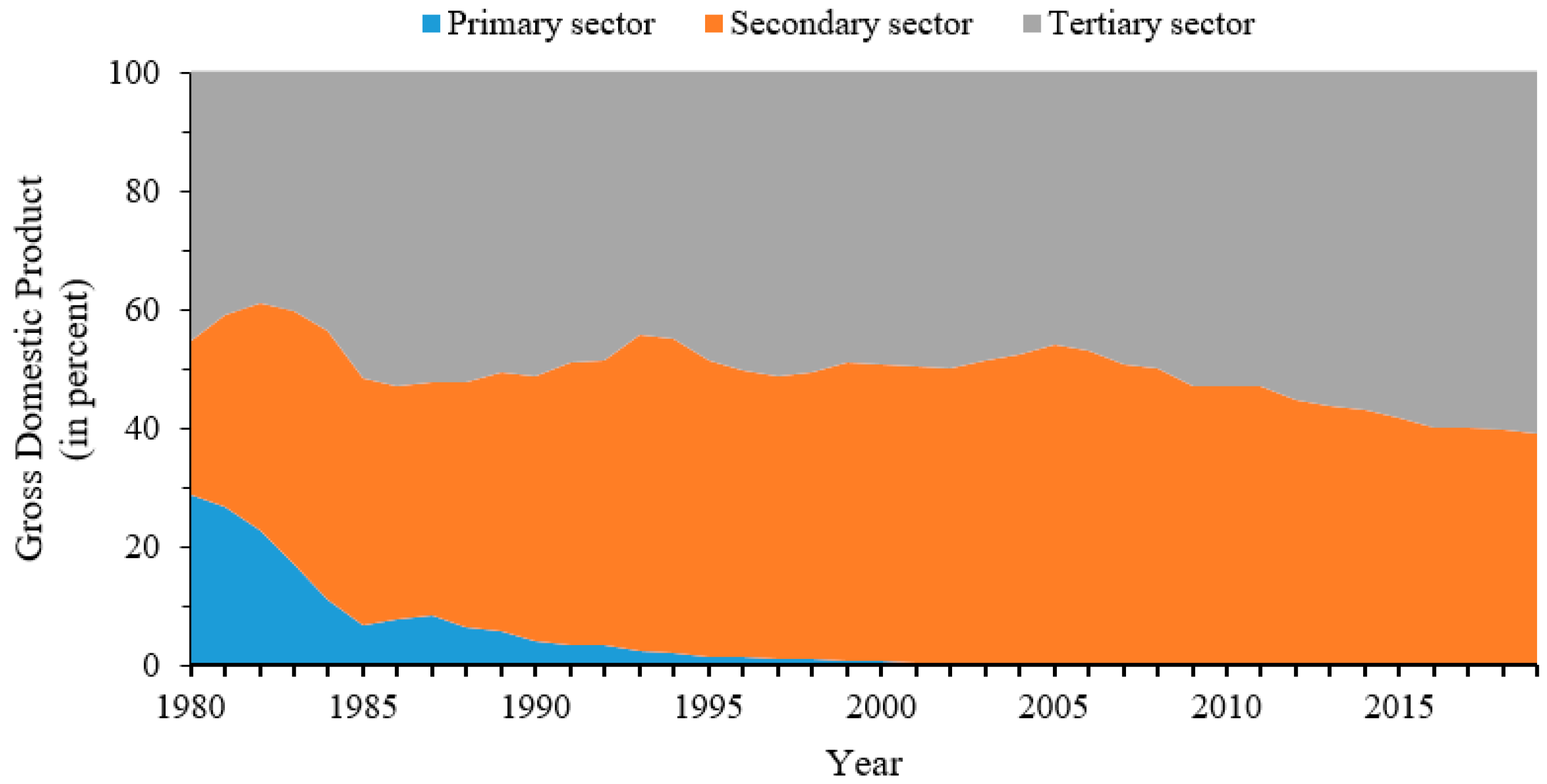

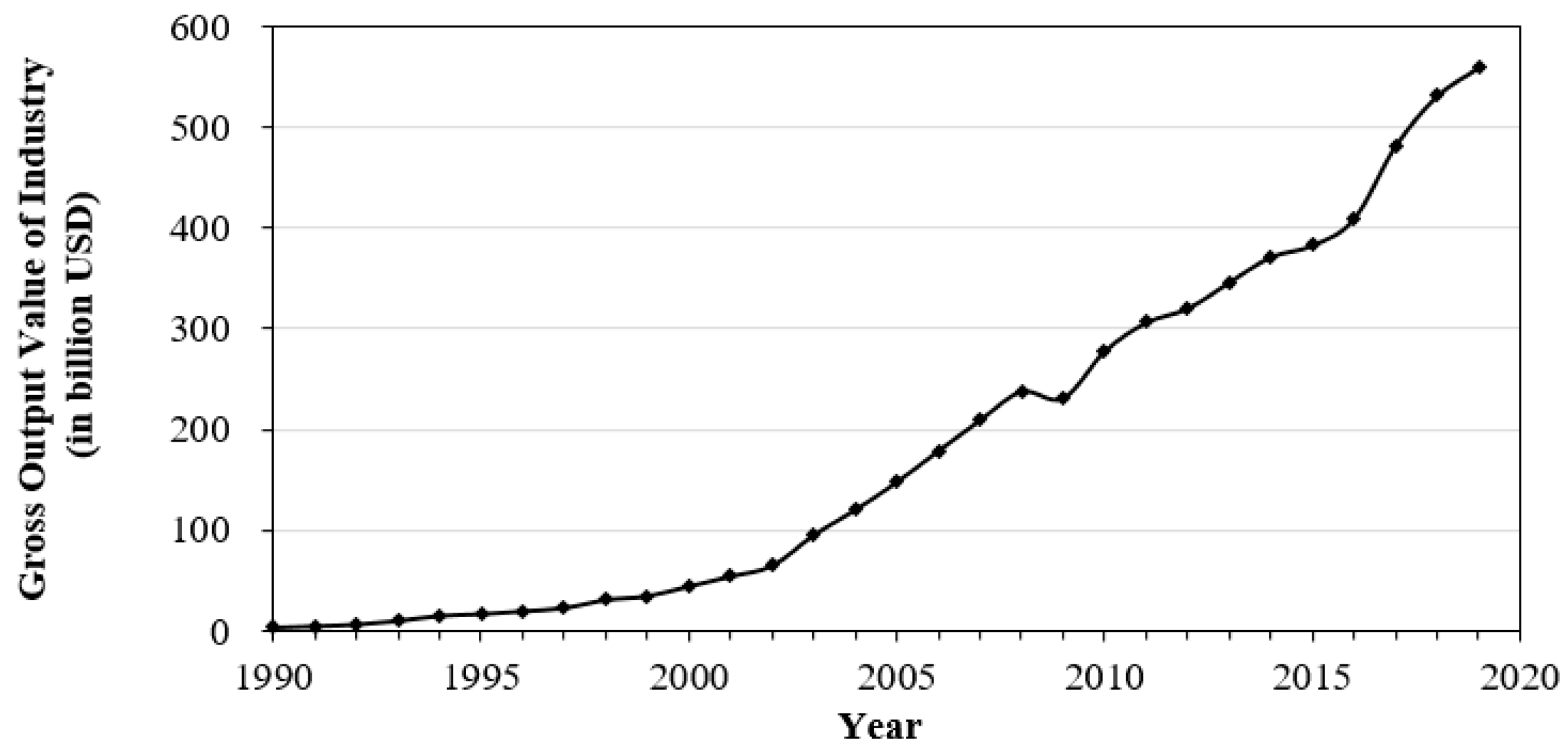
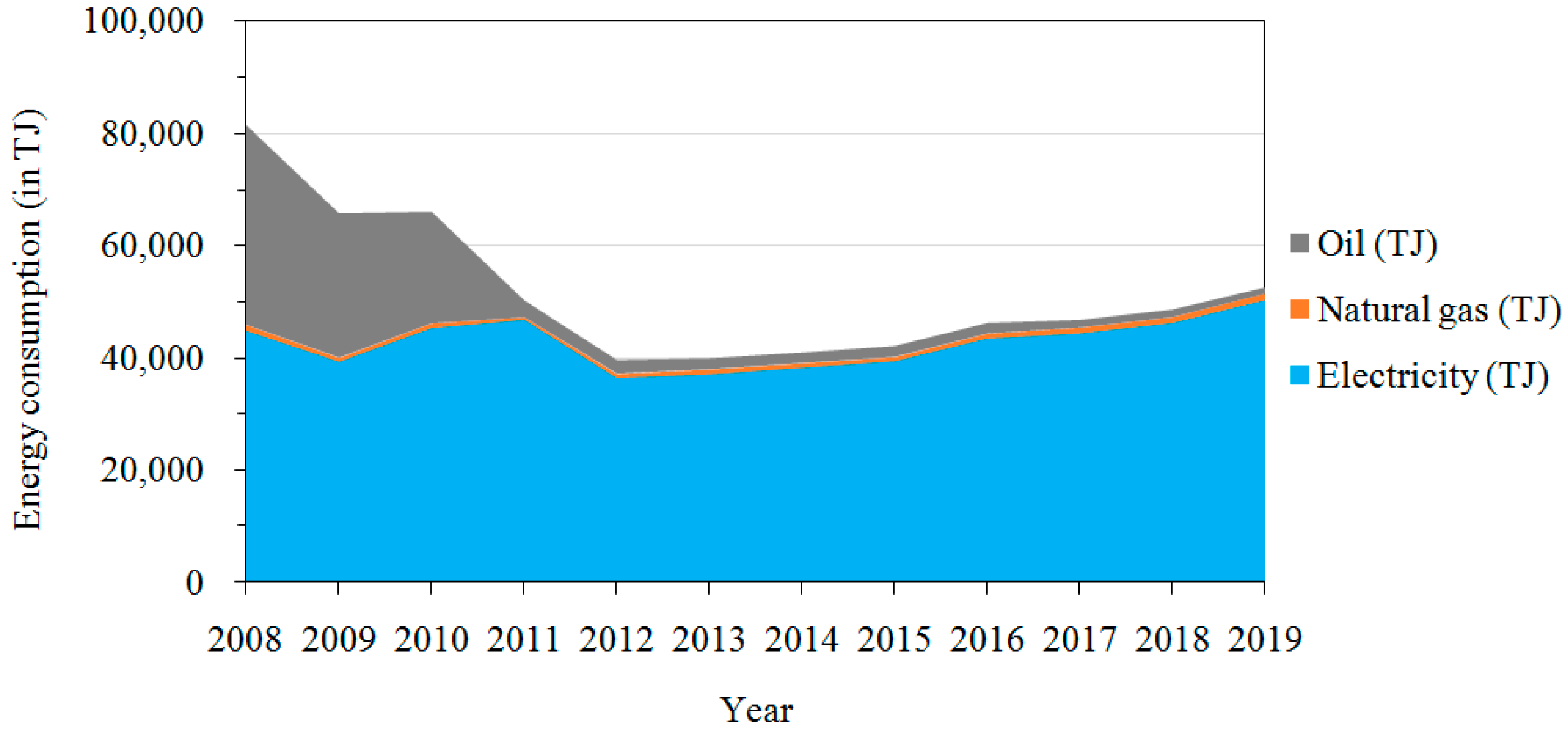
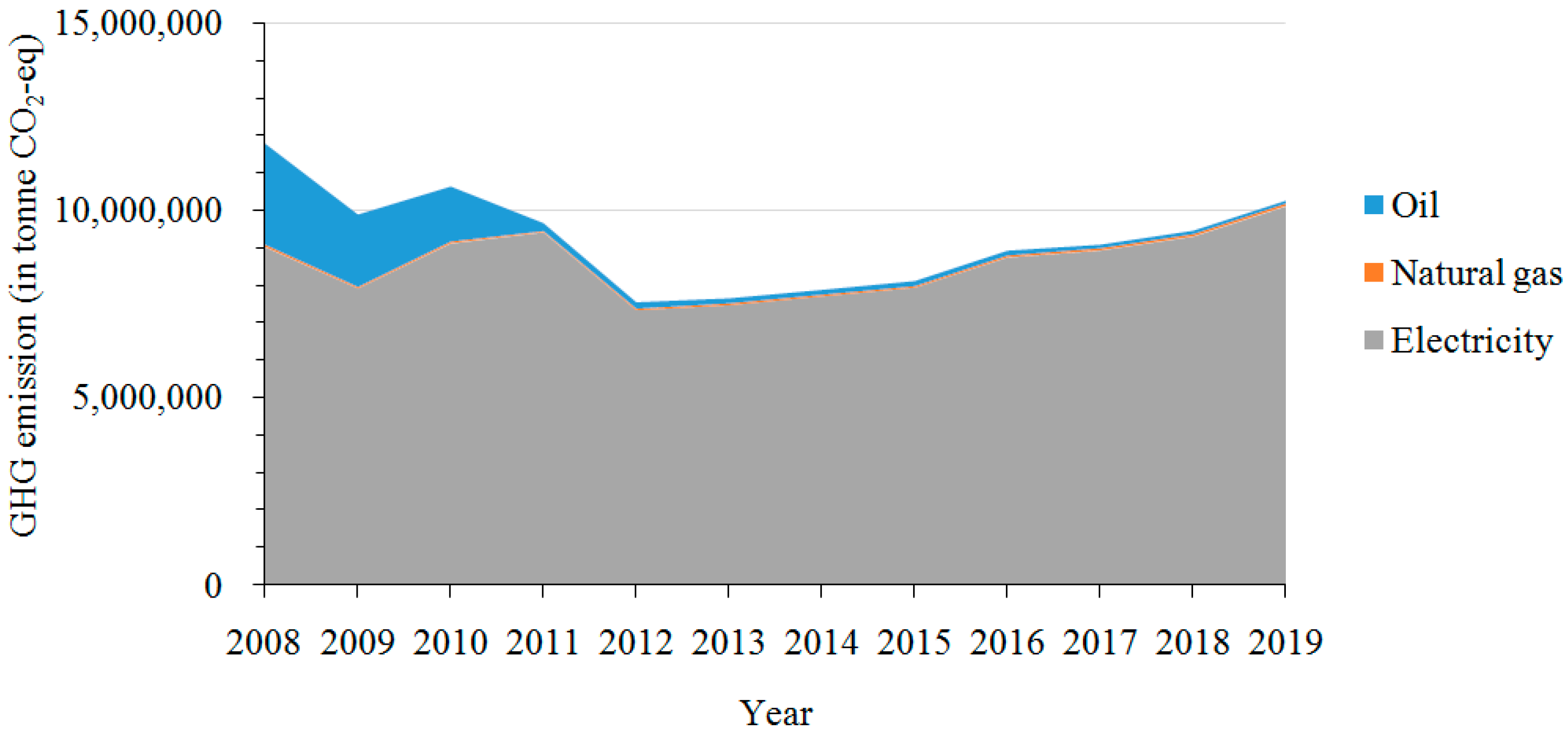
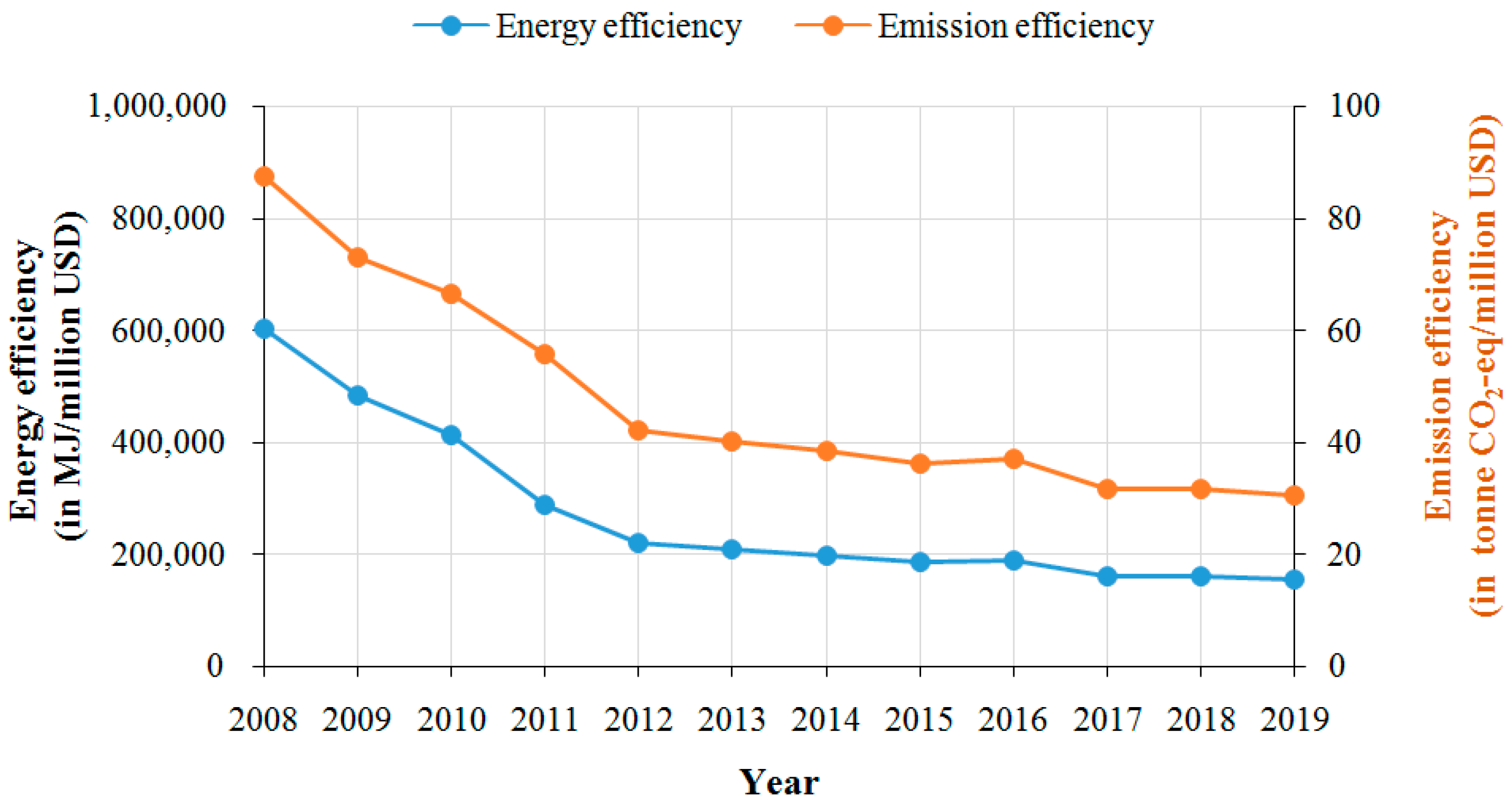
| Fuel | Calorific Values | GHG Emissions kg/TJ | ||
|---|---|---|---|---|
| CO2 | CH4 | N2O | ||
| Crude oil | 42,300 MJ/ton | 73,300 | 3 | 0.6 |
| Gasoline | 44,300 MJ/ton | 69,300 | 3 | 0.6 |
| Kerosene | 43,800 MJ/ton | 71,900 | 3 | 0.6 |
| Diesel oil | 43,000 MJ/ton | 74,100 | 3 | 0.6 |
| Fuel oil | 40,400 MJ/ton | 77,400 | 3 | 0.6 |
| LPG | 47,300 MJ/ton | 63,100 | 1 | 0.1 |
| NG | 369,230 MJ/10,000 m3 | 56,100 | 1 | 0.1 |
| Year | Total GDP in Billion USD | GDP by Sector in Billion USD (Percent) | ||
|---|---|---|---|---|
| Primary 1 | Secondary 2 | Tertiary 3 | ||
| 1980 | 0.04 | 0.01 (28.9) | 0.01 (26.0) | 0.02 (45.1) |
| 1985 | 0.59 | 0.04 (6.7) | 0.25 (41.9) | 0.30 (51.4) |
| 1990 | 2.58 | 0.11 (4.1) | 1.15 (44.8) | 1.32 (51.1) |
| 1995 | 12.64 | 0.18 (1.5) | 6.34 (50.1) | 6.12 (48.4) |
| 2000 | 33.28 | 0.23 (0.7) | 16.63 (50.0) | 16.42 (49.3) |
| 2005 | 75.54 | 0.15 (0.2) | 40.65 (53.8) | 34.74 (46.0) |
| 2010 | 151.04 | 0.09 (0.1) | 70.92 (47.0) | 80.03 (52.9) |
| 2015 | 276.55 | 0.11 (0.1) | 115.31 (41.6) | 161.13 (58.3) |
| 2019 | 403.91 | 0.38 (0.1) | 157.44 (39.0) | 246.09 (60.9) |
| Year | Population in Million | GDP per Capita in USD | Number of Haze Days per Year 1 |
|---|---|---|---|
| 1980 | 0.333 | 122 | 7 |
| 1985 | 0.882 | 664 | 16 |
| 1990 | 1.678 | 1535 | 15 |
| 1995 | 4.492 | 2815 | 90 |
| 2000 | 7.012 | 4747 | 73 |
| 2005 | 8.278 | 9126 | 161 |
| 2010 | 10.372 | 14,562 | 115 |
| 2015 | 11.379 | 24,304 | 35 |
| 2019 | 13.429 | 30,078 | 9 |
| Year | Computer | Mobile Phone 2 in Million | Electronic Product | |||
|---|---|---|---|---|---|---|
| Computers 1 in Million | Printers 1 in Million | Hard Drives 1 in Million | El. Comp. 3 in Million | Semicond. IC 3 in Million | ||
| 1985 | >0.01 | |||||
| 1990 | 0.02 | 3.10 | 0.01 | |||
| 1995 | 0.19 | 1.95 | 2.00 | 96.82 | 0.15 | |
| 2000 | 1.08 | 5.08 | 8.67 | 5.27 | 0.88 | |
| 2005 | 11.44 | 9.85 | 22.67 | 35.78 | 26.01 | 2.68 |
| 2010 | 34.03 | 19.74 | 68.66 | 320.19 | 218.63 | 12.41 |
| 2015 | 27.79 | 13.05 | 44.40 | 370.31 | 111.91 | 13.11 |
| 2019 | 29.47 | 5.39 | 2.61 | 224.80 | 283.04 | 31.04 |
| Primary Energy from Fossil Fuels | Electricity in Billion kWhr | |||||||
|---|---|---|---|---|---|---|---|---|
| Oil Products (in Kilotonne) | NG in | |||||||
| Year | Crude Oil | Gasoline | Kerosene | Diesel Oil | Fuel Oil | LPG | Million m3 | |
| 2008 | 42.48 | 0.35 | 333.10 | 473.84 | 3.25 | 28.64 | 12.46 | |
| 2009 | 0.10 | 34.36 | 0.64 | 351.61 | 220.34 | 2.76 | 18.43 | 10.94 |
| 2010 | 40.10 | 1.00 | 413.80 | 2.18 | 3.37 | 22.98 | 12.59 | |
| 2011 | 25.90 | 0.14 | 37.75 | 1.94 | 2.99 | 12.21 | 13.00 | |
| 2012 | 23.26 | 0.09 | 28.38 | 1.34 | 2.52 | 20.02 | 10.14 | |
| 2013 | 22.59 | 0.13 | 18.36 | 0.87 | 2.08 | 23.70 | 10.32 | |
| 2014 | 23.67 | 0.06 | 16.11 | 0.34 | 1.72 | 21.27 | 10.65 | |
| 2015 | 27.52 | 0.03 | 13.65 | 0.29 | 2.53 | 19.74 | 10.97 | |
| 2016 | 21.14 | 0.05 | 10.99 | 0.23 | 9.90 | 24.01 | 12.08 | |
| 2017 | 19.47 | 0.06 | 9.74 | 0.54 | 1.08 | 28.15 | 12.33 | |
| 2018 | 18.94 | 10.96 | 0.15 | 0.64 | 28.25 | 12.85 | ||
| 2019 | 18.40 | 6.91 | 0.11 | 0.40 | 32.62 | 13.96 | ||
Publisher’s Note: MDPI stays neutral with regard to jurisdictional claims in published maps and institutional affiliations. |
© 2021 by the authors. Licensee MDPI, Basel, Switzerland. This article is an open access article distributed under the terms and conditions of the Creative Commons Attribution (CC BY) license (https://creativecommons.org/licenses/by/4.0/).
Share and Cite
To, W.-M.; Lee, P.K.C.; Lau, A.K.W. Economic and Environmental Changes in Shenzhen—A Technology Hub in Southern China. Sustainability 2021, 13, 5545. https://doi.org/10.3390/su13105545
To W-M, Lee PKC, Lau AKW. Economic and Environmental Changes in Shenzhen—A Technology Hub in Southern China. Sustainability. 2021; 13(10):5545. https://doi.org/10.3390/su13105545
Chicago/Turabian StyleTo, Wai-Ming, Peter K. C. Lee, and Antonio K. W. Lau. 2021. "Economic and Environmental Changes in Shenzhen—A Technology Hub in Southern China" Sustainability 13, no. 10: 5545. https://doi.org/10.3390/su13105545
APA StyleTo, W.-M., Lee, P. K. C., & Lau, A. K. W. (2021). Economic and Environmental Changes in Shenzhen—A Technology Hub in Southern China. Sustainability, 13(10), 5545. https://doi.org/10.3390/su13105545







